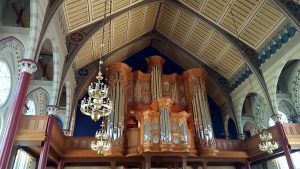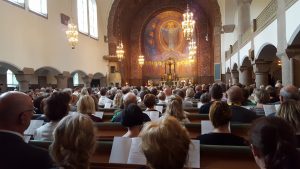This past summer I was fortunate to attend the Gothenburg International Organ Academy, an annual meeting of world-renowned scholars, teachers and organ-builders on the west coast of Sweden.
The overarching theme of the week was exploring the pictorial in organ music, chiefly through two different organ schools – the French school, focusing on the works of Olivier Messiaen, and the North German Baroque school, focusing on the themes of battle and lament in organ music of the late 17th and early 18th centuries.
These offerings were supplemented by workshops on the art of silent movie improvisation, a close cousin to the accompaniment of the liturgy, where one is often called to instantaneously compose music reflecting action, drama, and mood.
Presentations and concerts complemented these workshops and lectures, providing an extremely rich and inspiring menu. In a happy coincidence, this year’s academy took place concurrently with the annual meeting of the Scandinavian Church Music Symposium, a convocation of 1,400 church music directors, organists, and priests from Norway, Sweden, Iceland, Denmark, and Finland. To someone who had lived and worked in Norway for more than three years, this provided full re-immersion into the moving worlds of Scandinavian hymnody and folk melody, as well as the perfect opportunity to speak in a quirky west coast dialect!

Musically, two sources of enlightenment stood out from the artistic riches of the week. The first was a glimpse into the sound-world of the North German Baroque. This was eloquently revealed during the 20 or more hours spent listening to the the North German baroque organ in Örgryte New Church. This remarkable instrument recreates the exact construction techniques and design philosophies of the famous 17th century German organ builder Arp Schnitger. It is tuned to a special system known as quarter comma meantone. Although this can sound quite foreign to modern ears, it has two major advantages. The first is that for the majority of keys, certain chords sound exactly in tune, since they are not compromised by being adjusted in order to ‘fit’ into the modern scheme. The second is that a small minority of keys do not sound in tune to our ears at all! Chords played in keys at the periphery of composition at that time (such as F sharp major) sound bitter and haunting, even wild.
Of course, every out-of-tune cloud has a silver lining. Our professor, Harald Vogel, from the University of Arts in Bremen, gave hours of illuminating talks and demonstrations about how such instruments can bring music to life, describing battles, mythical creatures, celebrations, and laments. Professor Hans Davidsson, from the Royal Danish Academy of Music, describes this transformative effect:
“In this organ, we have not sought to reproduce a single historical organ from the past. Rather, we have used historical principles, materials, and techniques, to create a new organ for the 21st century, one which is able to open minds and reveal new vistas, previously unseen. We have truly created a ‘Laboratory of Sound’, one that will be available for generations to come.”
As I sat in Örgryte Church, soaking up the music, it was refreshing to be reminded of the potential of the organ to move hearts and minds in this way. I have often regarded the organ as the heartbeat of the musical life of any church, containing the power to enfold a congregation with warmth and color, delight an audience with dynamism of sound, and uplift worship with strong foundational support. The organ in Örgryte does all that, and more.
Which brings me onto the second source of enlightenment during this remarkable week: attending the closing Eucharist of the Scandinavian Church Music Symposium. Although all Scandinavian church languages are similar (except Finnish, which is related to Hungarian), they are not exactly the same. They vary in cadence, syntax, and vocabulary. However, when 1,400 nordic church musicians come together to lift their voices in liturgical song, those differences are academic.

Beginning with a Sami Joik, the service took us through the fjords of Norway to the volcanic moonscape of Iceland; it reminded us of the north European heritage of Denmark, and celebrated the folksong of Sweden. Together, we all joined our voices, aligning our melodies to the note of the organ, and committing ourselves to another year of musical service in our different congregational settings.
Proclamation, community, and service, celebrated through the joint endeavor of music and song. Visionary new worlds, created in laboratories of sound.
May these be our guiding lights, as we begin another year of music at Christ Church Greenwich.
September 2016
